Industry Growth Forum Journeys
Follow Along With Three Presenters in Pursuit of the 2022 Pitch Competition Win
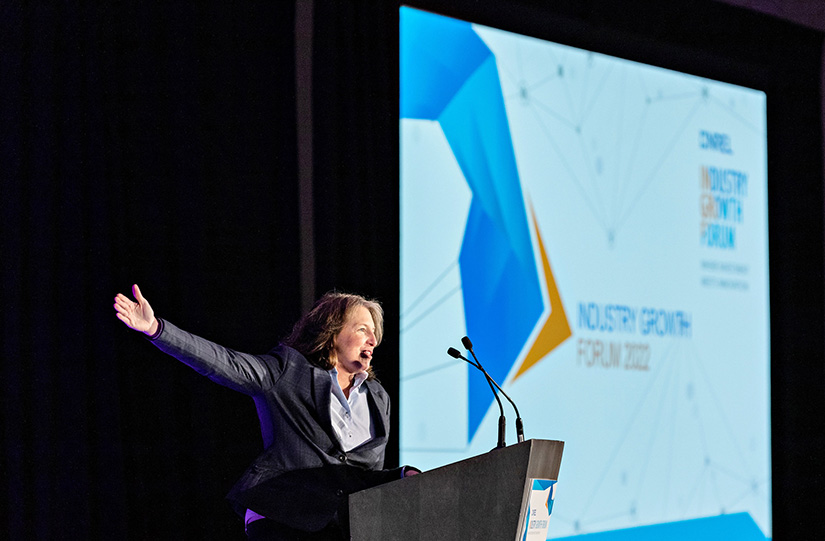
A week before he gave his pitch at the 2022 NREL Industry Growth Forum (IGF), Peak Power’s Chief Strategy Officer and Co-Founder Imran Noorani was scuba diving in a remote area on the edge of the Caribbean Sea looking for a specific type of shark.
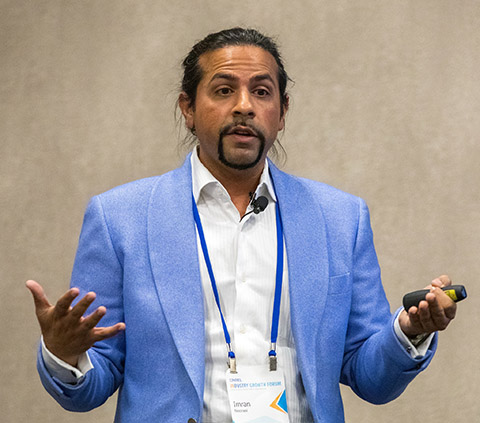
Thresher sharks are very rare and endangered. They are different than other sharks in that they have a long tail they use to sting prey. They live mainly in deep, cold water. Noorani did not find any thresher sharks while diving off Saba Island, northwest of Saint Kitts, but he did spot three reef sharks, and many “survivors” of shark attacks, such as turtles without limbs and sting rays without stingers. While he did not find what he was looking for while diving, he hoped for a different outcome at the IGF.
The dives were held to raise money for virology research. Noorani and his fellow divers went down three times a day to raise funds, as well as to document and observe what they saw. The team raised funds similar to the way people pledge runners in charity races.
“The money will go toward humans, but we’re looking for sharks because that’s what we like to do,” he said.
The Event
Noorani delivered his presentation during the two-day IGF, April 13–14, 2022, at the Gaylord Rockies Resort and Convention Center in Aurora, Colorado. Hosted by the National Renewable Energy Laboratory’s (NREL’s) Innovation and Entrepreneurship Center (IEC), the IGF, which just finished its 27th conference, is the premier event for cleantech entrepreneurs, investors, and experts from industry and the public sector to build relationships, showcase innovative technologies, and identify disruptive business solutions.
Noorani was one of 40 IGF presenters among more than 450 attendees and more than 50 exhibitors. During the IGF, startups not only present, but they also join one-on-one meetings with investors. This year, attendees participated in nearly 900 meetings with a pool of 105 investors. IGF attendees collectively focus on bringing new, cutting-edge, and economically viable cleantech to the market to achieve positive environmental impacts.
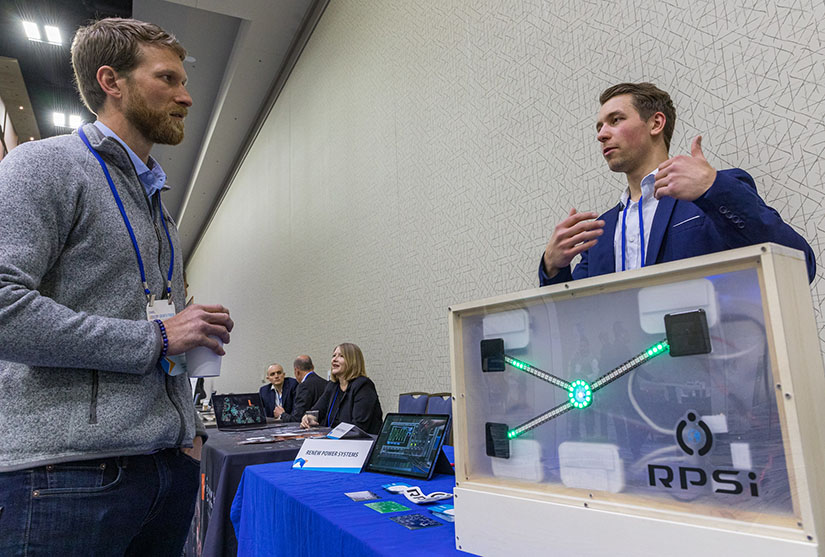
NREL’s IEC hosts the event and manages several partnerships with outside companies. IEC programs include the Wells Fargo Innovation Incubator (IN2), which supports startups that work in commercial buildings, affordable housing, and sustainable agriculture technologies; the Shell Gamechanger AcceleratorTM Powered by NREL (GCxN), which provides cleantech startups with access to NREL's world-class research and facilities, along with the incubation expertise of the Shell GameChanger program; and Chevron Studio, a brand-new program announced during the IGF opening session. Chevron Studio will link entrepreneurs with national laboratories and universities to scale up and commercialize innovative, early-stage technologies with the potential to enable a lower-carbon future. In a first-of-its-kind program, Chevron Technology Ventures, a division of Chevron U.S.A., and NREL, through its management and operating contractor, Alliance for Sustainable Energy LLC, will support entrepreneurs as they source and discover potential technologies, and provide technical assistance to enable development and scaling through incubation and demonstration trials. Potential project areas include carbon conversion and utilization, energy storage systems, and solutions for a circular economy.
“Bringing economically viable cleantech solutions to market is a contact sport,” said NREL Innovation and Entrepreneurship Center Director Trish Cozart. “Watching all the investors and startup companies make those needed connections again in person was incredible. Our theme of ‘Better Together’ was really realized in this event. We need each other to foster business success and push the boundaries of technology."
Several startups at the IGF are either already part of one of the IEC-managed programs, are alumni, or would like to be in the future. Whatever path forward, the startups all want to ensure the investors at the event know about and understand what these companies bring to the table.
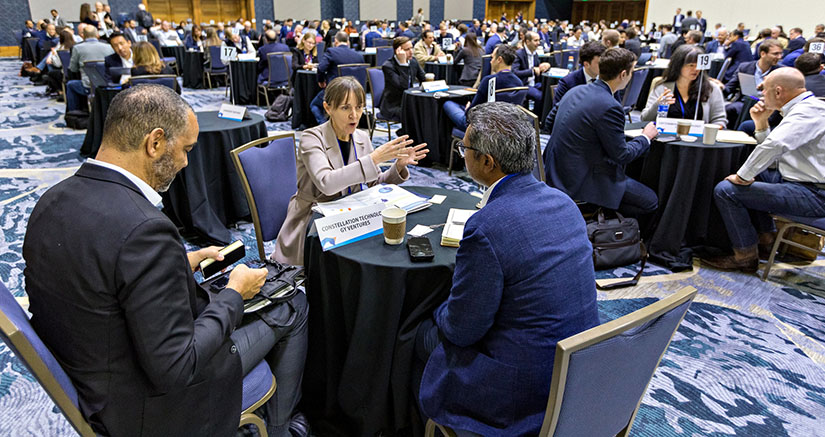
The Startups
Noorani’s company, Peak Power, based out of Toronto, Canada, created a software platform that provides decarbonization solutions for commercial real estate and industrial customers by optimizing three core energy assets: battery energy storage systems, grid-interactive buildings, and electric vehicles. The Peak Synergy platform enables customers to minimize operational costs, reduce emissions, and sell energy back to the grid. Additionally, Peak Power guides customers on financing and energy storage deployment, and manages the operation of assets once they are installed.
“We’ll help our customers find the money to do the project, as well as provide full support to get them up and running. We help them get the most out of their assets, all in one platform,” Noorani said. “It’s more than just figuring out where and when to maximize an organization’s efforts; it’s actually doing it.”
The IGF marked Peak Power’s official launch of its series A fundraising period focused on getting U.S. funding and branding.
“Our goal is very much to secure investors from the U.S. that have partnerships where it will allow us to expand to many different sites,” Noorani said.
Eddy Chiang, co-founder and CEO of Moment Energy, also used the IGF to kick off series A funding. Based in Vancouver, Canada, Chiang came to present on how his company takes batteries out of end-of-life electric vehicles (EV) to provide stationary storage.
“Due to the high cost of recycling, only 5% of EV batteries are getting recycled. They either end up on shelves or in landfills, but there’s an average of 80% of life left in these batteries,” Chiang said. “So, we want to repurpose them from an EV into commercial and industrial buildings.”
Chiang lived in rural Canada for a while, in Deep River, a small town of no more than 3,000 people located two hours north of Ottawa. He experienced his first 24-hour power outage after a tornado hit Ottawa in 2018. Residents there told him that sometimes they could lose power for up to a week.
“That’s because their energy is unreliable and dirty. They typically have a diesel generator, but you need fuel for that and it’s loud and pollutant. You could try solar and wind, but that can be intermittent, so you need a battery. But there are problems with that as well: Lithium is very expensive, and the lead-acid batteries are not safe,” Chiang said. “EV batteries perform better at a more affordable price point.”
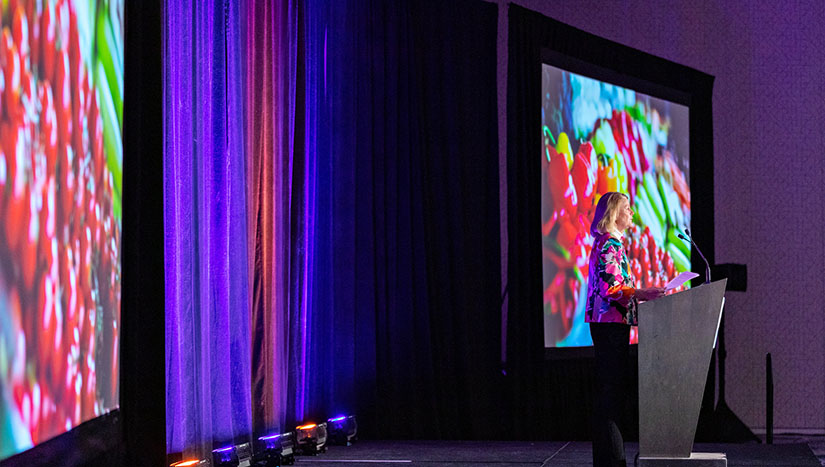
Canada is not the only place this could make a difference. Communities around the world, in developed and underdeveloped countries, face problems with sustainable power.
“Energy storage solutions make sense for areas that are diesel dependent,” he said. “During times where fuel is being wasted and the generator is not being used, we can create a system similar to a hybrid car. You can charge the battery with the wasted generated energy, and then when fully charged, we can cut off the generator altogether, reducing fuel consumption by 40%, seeing overall reduction in the carbon footprint.”
Trevor Best, founder and CEO of Syzygy Plasmonics, hopes this year’s IGF will help with their series C fundraising. The company previously raised just under $40 million across multiple rounds, but this time the money will go toward a major step forward.
“We have developed our tech to a point that we are ready to enter the market,” Best said. “We’re also looking for field-trial participants. We have a very full pipeline, but we need more. Now is the time to talk to us, or you’re going to miss the boat.”
Syzygy Plasmonics focuses on tackling the trillion-dollar chemical value chain that dominates industry and is driven by combustion, which creates a gigaton of carbon emissions every year. The massive chemical value chain is made up of products that many have heard of but hardly ever interact with. Examples include molecules like hydrogen, methanol, ammonia, aromatics, and olefins. Overall, a combination of fossil fuels powers chemical manufacturing, and that is the problem Syzygy Plasmonics aims to solve.
“We want to replace chemical reactors powered by combustion of fossil fuel with our reactors that are powered with light from LEDs that are driven by renewable electricity. We have many different catalysts that do many types of chemical reactions, and we put these into the photocatalytic reactor we developed. Because we’re using light instead of heat, our reactor can be built from low-cost materials like aluminum and glass,” Best said. “Chemical energy is something planet Earth has always been hungry for, and in the future, electricity may dominate, but chemical energy is not going away. You always hear that running a startup is like building the plane as you fly it. Well, when we land this plane, it changes the world.”
Syzygy Plasmonics hopes to help large chemical and petrochemical operations with their photocatalysis.
“It’s one of those Holy Grail things people have been trying to do for five decades, and we are succeeding. Ours is, I believe, the world’s first high-performance photocatalyst, orders of magnitude more stable and efficient from what’s come before,” Best said. “We are literally bringing a new field of science into the fight against climate change.”
Best said they started focusing on zero-emission hydrogen in 2017, before it became popular.
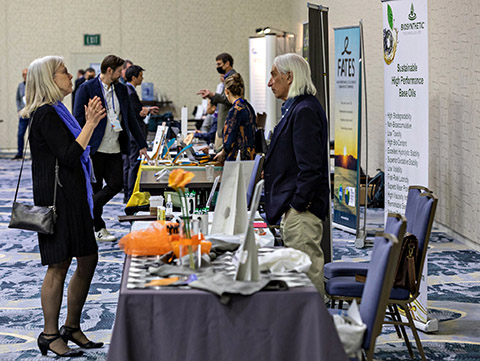
“In 2018, nobody was talking about hydrogen like the way they are now, but we anticipated that would change. It’s about skating to where the puck is going to go, and we do not see a world that is decarbonized without hydrogen playing a central role. It’s like a Swiss Army knife because you can use it for clean energy, energy storage, and it solves many of the problems with energy transition,” Best said.
For Best, the IGF started on the evening of Tuesday, April 12, 2022, because Syzygy Plasmonics sponsored a happy hour event for the other startups at the conference.
“This is very personal for me—I love other startups, and I love other founders. Scaling cleantech is one of the most difficult pathways a human being can choose for their lives. I love the people that have chosen that path, and if I can help give them an event to gather around, I think that is phenomenal,” Best said.
More than 60 people attended Tuesday night’s happy hour, representing the 40 startups chosen to present at the conference. The atmosphere was excitement with an undercurrent of apprehension as all prepared for the next two days of meetings, presentations, and relationship building.
“It just makes me so happy when people get together and share a drink and not worry about pitching or about how the event on stage is going to go tomorrow,” Best said during the happy hour. “If you look around, a lot of people here are smiling.”
Best knows, however, that everyone is a bit nervous, even if they regularly attend events like the IGF.
“I pitch so much, and I’m always excited, so being on stage is very natural to me,” Best said.
On Wednesday and Thursday, the 40 startups delivered presentations to the rest of the IGF about their cleantech. At the end, a panel of judges selected the winners of the pitch competition. All startups would appreciate the recognition and notoriety that winning could bring.
“Even being here helps to showcase us to investors and intensify the interest they have in us. If we’re able to win, all the better. But it’s a tough crowd with stiff competition. The other startups here presenting definitely aren’t pushovers. They are very viable, exciting companies. I feel privileged to be here amongst them,” Best said.
However, the most important part of the IGF may have nothing to do with the presentations. On Wednesday morning, all the startups enjoyed one-on-one meetings with investors in 10-minute sessions held over three hours.
“You don’t have to win the competition or get one of the awards to get the benefit of the IGF,” said Bill Farris, NREL’s associate laboratory director for Innovation, Partnering, and Outreach. “Because of the one-on-one investor meetings, and other meetings as well, they all win. That is where success can really sprout and grow.”
What Success Looks Like
Best, Noorani, Chiang, and the rest of the startups all hope for a success story similar to that of SweetSense Inc., which spun out of a university research lab to help low-income countries in sub-Saharan Africa get access to clean water through satellite-connected sensor monitoring. About 15 countries now use the sensors from SweetSense to monitor water filters, pumps, and community water supplies.
“About three years ago, we broadened our vision to study where our products can be useful in the U.S. The 20-year mega drought in the American West created an urgency to improve groundwater, land, and energy management,” said SweetSense CEO and Founder Evan Thomas. “We help landowners with water and soil conservation and energy cost savings.”
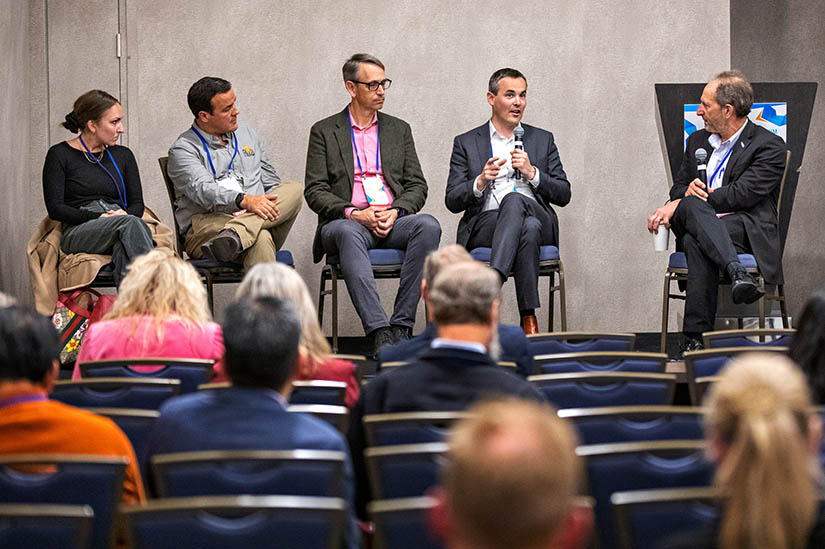
Thomas is also an engineering professor at the University of Colorado–Boulder and leads the Mortenson Center in Global Engineering, but the company started when he was a professor in Oregon.
In April 2020, when Thomas presented at the IGF, they were looking for venture capitalist (VC) funding.
An investment bank, Young America Capital, saw the presentation and followed up after the event, agreeing to be a representative for SweetSense in the search for venture capital. That led to a series A investment from a VC in California called Accord Capital. Last October, they invested $5 million in SweetSense. This investment not only helps SweetSense market to farmers in the American West, but it supports communities in Africa as well.
“These new markets support our engineering development costs and makes the product cheaper and more scalable for clients in Africa,” Thomas said.
During the 2022 IGF, Thomas joined a panel on Pathways to Commercialization, part of the Emerging Markets Perspectives on Wednesday afternoon. The aim of the panel was to explore the different challenges faced at various stages of a startup’s development and highlight available resources that entrepreneurs can leverage to overcome those challenges.
“It was really nice to be able to share our story,” Thomas said after the panel. “What I appreciate about the Industry Growth Forum is that they’ve cultivated a group of investors that focus on the tech and the mission. They are pre-calibrated to know that these are hard problems that deserve investment and attention.”
One-on-One Meetings
After opening remarks Wednesday morning, the 10-minute one-on-one meetings between startups and investors began. This is the real bread and butter of the IGF, where startups make connections that can increase the pace of getting their cleantech to the market. Best met with two potential partners early on: Hamilton Clark Sustainable Capital and Hennessy Capital Group. Both organizations expressed interest in Syzygy Plasmonics and wanted Best to follow up with more information.
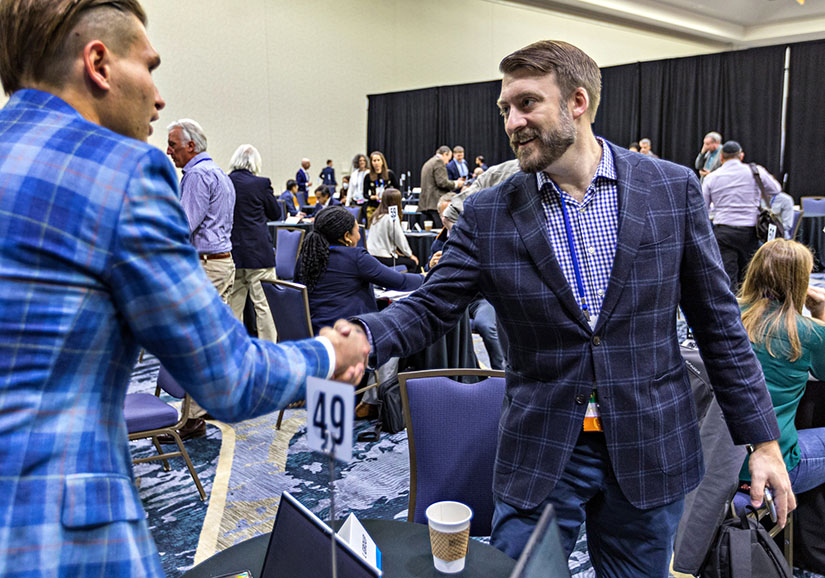
“We are an ideal candidate for them. We are at the stage they are looking for,” Best said. “We are at the commercialization stage, and that’s what many of these investment banks want to connect with right now.”
Chiang had continuous meetings during the one-on-one sessions and ended the day excited about what could come from those.
“It’s been back-to-back, but it’s great,” Chiang said. “I love this. This morning was wonderful. It’s so great to be with other startups that have the same struggles. Cleantech is hard, it’s expensive, but we got the chance to meet with people who truly understand cleantech and what it takes to create a company that makes tangible, positive impact on people’s lives.”
Chiang remarked about how unique and valuable the IGF is compared with other cleantech events.
“Many events are not like this; it’s just a series of TED talks. It’s so great that this one is well organized and actually gives startups a chance to showcase what they are doing,” he said. “Instead of hearing from the head of a very large, established company and their promises, the startups that are on the ground innovating are actually pitching.”
Noorani expressed similar enthusiasm about the entire event.
“This is a true testament to NREL. Bringing all these people together—it’s brilliant,” Noorani said. “The energy is here. Coming out of COVID and not having many conferences face to face, this is wonderful.”
Noorani said the structure also allowed him to schedule three months’ worth of meetings in the span of just two days. He had 12 on Wednesday morning, another 12 on Wednesday afternoon, and five more on Thursday. In all, the IGF hosted nearly 900 one-on-one meetings between investors and startups and an additional 1,000 ad hoc meetings over the two days.
“This is the return on investment—30 meetings in a day and a half. This is what I love specifically about events like this, is that when it’s organized you can really get what you need,” Noorani said.
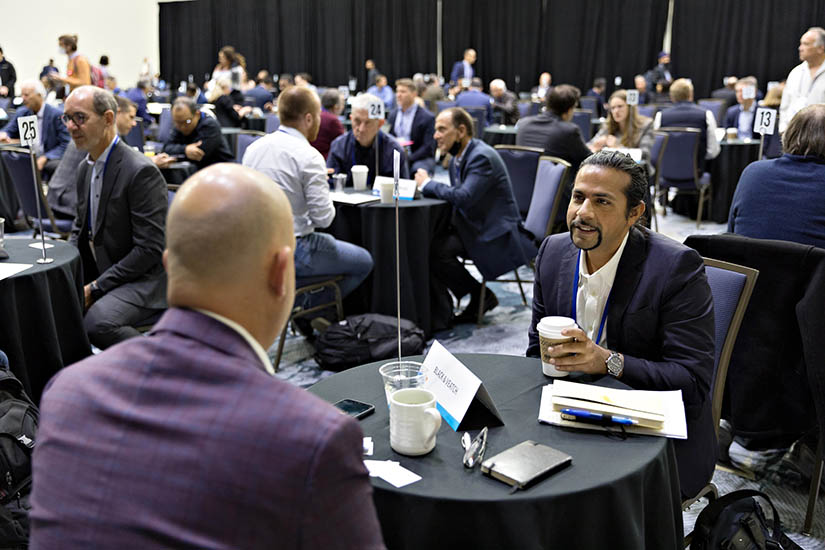
He said it may be even more important than winning the pitch competition, although he still hoped to do that.
“This is winning—these meetings. However, we would still like to win because we need to boost our branding in the U.S., and it spotlights us as a Canadian company. Winning the competition means this emerging Canadian company is something to pay attention to,” Noorani said.
The Pitches
Noorani gave his presentation on Thursday morning, and it represented a new step for Peak Power as they simplify what they discuss during pitch sessions. They previously positioned themselves as a local grid-focused organization, but they wanted to think more globally.
“I’m not nervous about the session, but I hope people understand exactly what we are doing. As climate change is so important, I’m hoping people understand the message and leaps they must make mentally. We’re taking a risk not being grid first. The grid is an assumption. This is about the world. Electricity is just a part of that world,” he said.
During his presentation, which was part of the Growth Stage session, Noorani began by declaring: “Everyone in the world has a right to energy.” He spent time laying out the problem Peak Power aims to solve before diving into how they can make a difference, specifically pointing out that the whole process has a “language barrier” at many levels. His animation and excitement were infectious, and people in the room leaned in as he went on.
“This market is complicated, but there’s a lot of capital to be deployed in this space,” he said. “We are proving the solutions.”
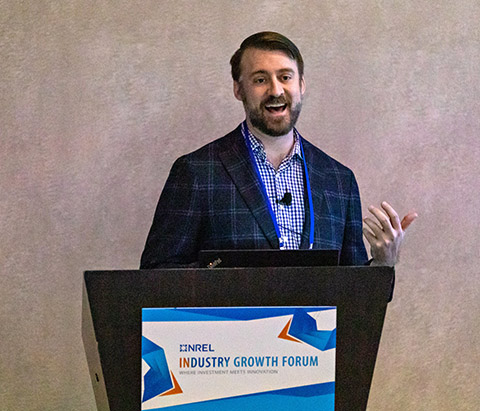
Best was one of the first presenters on Wednesday afternoon, the first person to speak during the Commercialization Stage session. He was clear and concise, simplifying their complex chemical improvements with easy-to-understand language. The language clearly connected with the group assembled in the room, with audible reactions to his presentations.
Judges evaluate presenters on five criteria, including the product and the solution they offer, the market opportunity and strategy involved, the startup’s business model, the management team in place, and the overall quality of the presentation.
After his presentation, Best expressed pleasure that he finished right as his time ran out.
“I don’t like it when I don’t have enough time, but I got to spend plenty of time digging into the team, the technology, and the economics,” he said.
The presentation also focused on the overall goal instead of digging deeply into the science.
“What we’ve found is if we talk too much about the technology, we lose people. The science behind what we’re doing is insane. I love the science, and I have had to pull back because if you get people too interested in the science in short meetings like this, they won’t have time. Then they miss all the value propositions,” Best said.
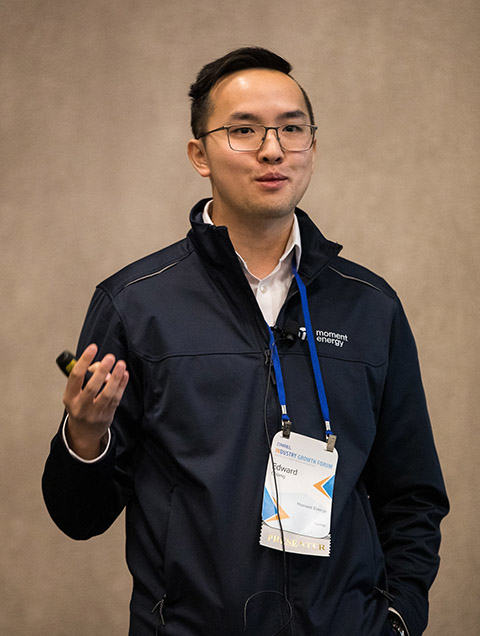
Chiang spoke on Thursday morning, less than an hour after Noorani finished his presentation. Part of the Emerging Markets session, Chiang was calm, collected, but still energetic. Those assembled to see him specifically tuned into when he talked about specific competitors in the same space as Moment Energy. He went through a point-by-point comparison, naming how his organization won out over others in detailed areas. After he was finished, many in the crowd lined up to congratulate him and he got into several involved discussions, especially with one investor.
“We have been talking to many investors and are focused on finding the right fit,” Chiang said. “I’m just excited that I was even presenting here at the Industry Growth Forum. I really appreciate the chance to present to so many investors and other startups making changes in the cleantech space. I appreciate the support of NREL and the Canadian organization MARS.”
The Winners
The event wound down with a lunch before Cozart announced the award winners. The IGF awarded five startups with awards, one for each category, a best-score overall winner, and a people’s choice award voted on by attendees at the conference.
The 2022 winners are:
- Outstanding Venture—Early Stage: Helicoid Industries, Indio, California
- Outstanding Venture—Commercialization Stage: Syzygy Plasmonics, Houston, Texas
- Outstanding Venture—Growth Stage: Biosynthetic Technologies, Indianapolis, Indiana
- Outstanding Venture—Emerging Markets: UCAP Power, San Diego, California
- Best Venture Award: UCAP Power, San Diego, California
- People’s Choice Award: South 8 Technologies, San Diego, California
Best looked thunderstruck as he walked off the stage with his award, saying he was over the moon.
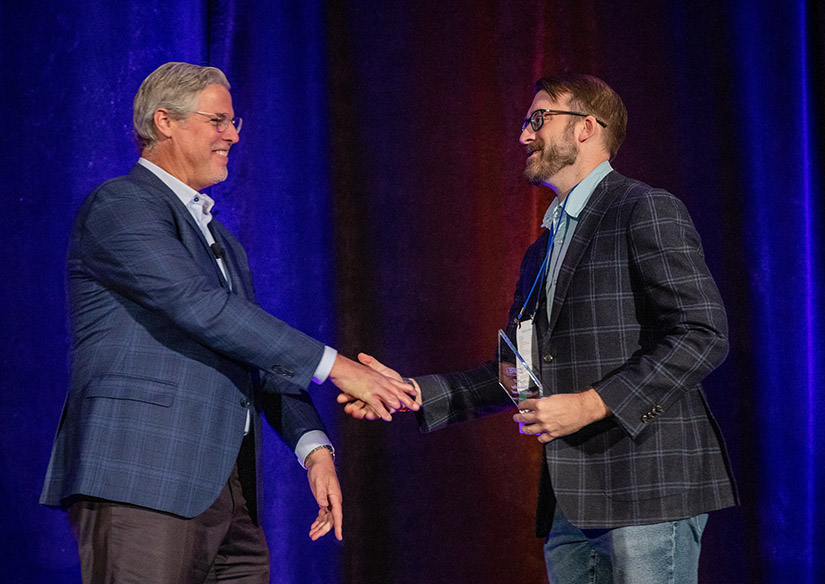
“You never expect to win, you hope you do, but, wow,” Best said. “It’s big for us. It’s validation to our investors. It’s a huge compliment to Syzygy’s team and all the hard work we’ve done. This is a proof point we are on the right track to decarbonizing the future.”
Even though he did not win, Noorani was not discouraged. He plans to get right back in the water and keep looking for sharks.
“Next year—we’ll come back for more,” he said. “I would have loved to see a Canadian company win one award, so next year will be the year.”
He says he has 29 follow-ups coming out of the IGF, with two VCs who approached him after his presentation and three other startups who want to connect.
“By watching our fellow startups pitch, we’re starting to see that not everyone’s our competitor; we work better together. There are great opportunities for collaboration because we’re all approaching climate change from different niches,” Noorani said. “I wouldn’t have missed this event for the world.”
Chiang felt similar, writing from the airport as he prepared to leave: “It was amazing to meet so many investors and startups that really believe in the need for climate action. We found so many fellow companies that we can work together with, as well as spoke with many investors that really believe in our vision. It means a lot to connect with people who understand what it takes to build tangible positive social and environmental impact.”
The sentiment about the event’s success was shared by many who attended. Presenters, investors, and others left with a sense of excitement and optimism.
“There’s no blueprint, we can make our mark, and we are out taking risks and doing that every day,” Cozart said during her closing remarks. “We need each other pushing each other forward, because truly we are better together.”
Organizers for the IGF ended the event with a sense of pride and are already looking forward to bringing people back again in 2023.
“This year was all we hoped it would be and more,” said IGF Project Manager Sheila Ebbitt. “We had nearly 550 attendees from all over the world. These folks are tackling the dangers created by climate change head-on, and the solutions they come up with will help the entire planet.”
In the end, Best summed up why he comes to events like the IGF, and why it is not his last stop.
“If you’re not having fun, what are you doing?” he asked. “Never stop smiling.”
Last Updated May 28, 2025
